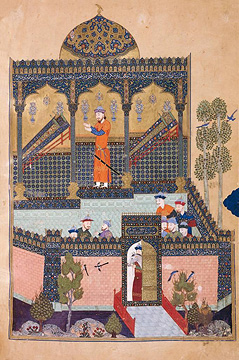Image Resource Bank
Image Gallery |  4 of 15
4 of 15 
Scene from the Shahnameh of Ferdowsi
This miniature (or small painting for a book) features Faramarz (in orange), a character of the Shahnameh, mourning at the tombs of his uncle Zavareh and father Rostam—the greatest hero of the book, akin to Hercules or Achilles. By the time of the Mongol conquests, it became very common for wealthy patrons to hire painters and illuminators as well as scribes for producing books, which were highly prized. The Shahnameh was especially popular in court-circles to the point where many kings and princes paid to have the epic copied and illustrated. This particular miniature comes from an edition produced under the patronage of the Prince Giyath al-Din Baysonghor (d. 1433 CE), a grandson of Timur. Timur’s dynasty is especially noted for producing a large number of illuminated texts, including several Shahnamehs.
While Europe prized large paintings to be exhibited on walls and enjoyed from a few feet back, Persian painting was mainly confined to miniatures for books that averaged the size of a standard modern sheet of paper, to be observed from the hands of the viewer so he or she could appreciate all the delicate and minute details. And whereas European painting increasingly stressed capturing a scene from a single perspective, Middle Eastern painting instead tried to present the image from multiple points of view with the goal of showing all the important details at once. As a result, Persian miniatures very often show the faces of everyone in the painting, or bend the walls or other structures at “strange” angles—or even removing the walls from a part of the building—in order to show off an important detail, such as the building’s façade or the people inside. For example, in this painting, the wall on the left was not painted parallel to the one on the right so as not to cut off any of the most-important part of the image, that is, of Faramarz mourning at the two tombs.
Name: Faramarz son of Rostam mourns the death of his father and his uncle Zavareh
Material: Paint on paper
Size:
Length: 38cm (15 in)
Width: 26cm (10.2 in)
Date: 1430 CE
Place of Origin: Timurid Empire
Location: Imperial Library of the Golestan Palace, Tehran, Iran
Source and Registration#:
Wikimedia![]()
(accessed February 5, 2010).

 Michael Sells
Michael Sells
John Henry Barrows Professor of Islamic History and Literature, Divinity School, The University of Chicago




